bio will ace
1/103
There's no tags or description
Looks like no tags are added yet.
Name | Mastery | Learn | Test | Matching | Spaced |
|---|
No study sessions yet.
104 Terms
metabolism
all of the chemical reactions in an organism
metabolic pathways
series of chemical reactions that either build complex molecules or breakdown complex molecules
a series of steps to produce a product- catalyzed by a specific enzyme
ex. substrate>enzyme1.> intermediate reaction>enzyme2.> intermediate reaction>product
two types of metabolic pathways
catabolic (cat-astrophe, breakdown, release)
anabolic (A na, A te, build up, consume)
catabolic pathways
pathways that release energy by breaking down complex molecules into simpler compound
ex. cellular respiration-breaking down glucose when O2 is present to make ATP
anabolic pathways
pathways that consume energy to build complicated molecules from simpler compounds
ex. synthesizing proteins from put together amino acids, putting monosaccharides together to build a disaccharide
energy
the ability to do work
necessary to survive and function
must be transferred from one form to another to live
a loss of energy results in
death
kinetic energy
associated with motion
thermal energy
associate with the movement of atoms or molecules
heat
type of kinetic (at the molecule scale)
heat
thermal energy that transfers from one object to another)
potential energy
stored energy
because of location or structure
chemical energy
type of potential energy (structure)
released in a chemical energy
thermodynamics
study of energy transformation in matter
its laws apply to all the universe
3 laws
1) energy cannot be created or destroyed, it can be transferred or transformed (principle of conservation of energy)
2) energy transformation increases entropy (disorder; [S]) of the universe, during transfers/transformations, some energy is unusable and is lost as heat
3) ?
entropy examples
heat
multiple pieces
solid(least) to liquid to gas (most disorder)
diffused particles/spaced apart
isolated system
unable to exchange energy or matter with its surroundings
open system
ex organisms
energy os transferred between the system and its surroundings
organisms pay for their complexity and organization by
creating disorder themselves
free energy
determines the likelihood of reactions in organisms or in the reactions are energetically favorable
delta G= delta H-TdeltaS
energy that can do wor is usable
delta G
change in free energy
high G
more free energy
less stable
greater work capacity
in spontaneous change
free energy of the system decreases (delta G<0)
system become more stable
released energy is harnessed to do work
low G
less free energy
more stable
less work capacity
delta H
change in total energy
T
absolute temp in kelvin
delta S
change in entropy
free energy change of reactions determine
whether reactions occur spontaneously (no outside input of energy is required)
based on this, reactions are classified as exergonic (expel) or endergonic (engorge??)
exergonic reactions
reactions that release energy (ex. cellular respiration)
delta G is less than 0
spontaneous
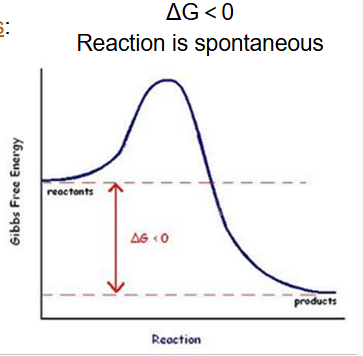
endergonic reactions
reactions that absord energy (ex. photosynthesis
delta G is greater than 0
not spontaneous (decrease entropy; require energy)
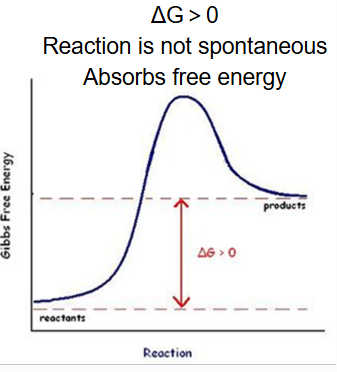
cells perform three kinds of work
mechanical
transport
chemical
mechanical work
movement
ex.beating cilia, movement of chromosomes, contraction of muscle cells
transport work
pumping substances across membranes against spontaeous movement
chemical work
synthesis of molecules
ex building polymers from monomers
ATP
adenosine triphosphate- molecule that organisms use for energy
couples exergonic to endergonic reactions to power cellular work
-the exergonic process drives the enderognic process
also used to make RNA
ribose, adenine (nitrogenous base) and three phosphate groups
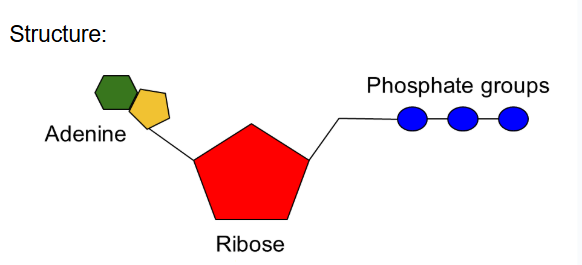
ATP>ADP (hydrolysis)
organisms obtain energy by breaking the bond between the 2nd and 3rd phosphate in a hydrolysis reaction (addition of water)
energy come from lowering (-delta G) of free energy, not phosphate bonds (more pieces, greater entropy, -delta G)
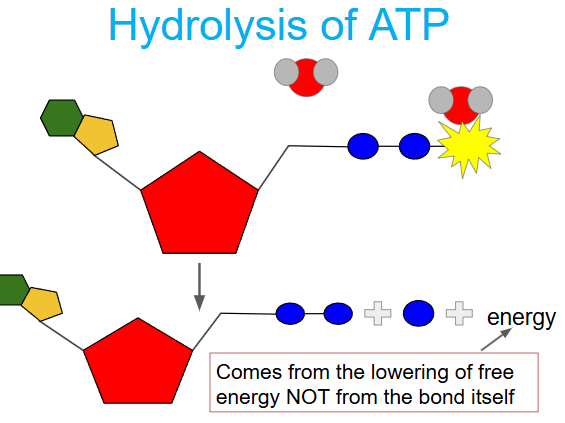
phosphorylation
the released phosphate moves to another molecule to give energy
regeneration of ATP
ATP cycle
ADP +Pi uses energy from exergonic process to become ATP and water and energy is released in hydrolysic for cellular work to become ADP +Pi
spontaneous reactions are not necessarily fast
can be sped up with enzymes
enzymes
type of protein that catalyze or speed up reactions by lowering activation energy
ends in -ase
not consumed by reaction
enzyme acts on
active site of a reactant called a substrate
ways enzymes lower activation energy
substrates may be oriented to facilitate reaction
substrate stretched to make bonds easier to break
active site may provide a microenvironment that favors the reaction
amino acids in active site may participate in reactions
enzyme function
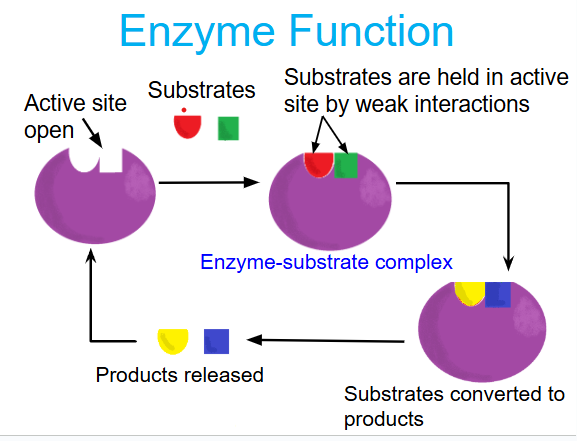
induced fit
enzymes will change the shape of their active site to allow the substrate to bind better
enzyme catabolism
enzyme break down complex molecule
enzyme anabolism
enzyme build complex molecules
shape of enzyme affected by
temperature
pH
chemicals
change in shape is a change in function
optimal conditions
best conditions (tmep and ph) for enzymes to function
cofactors
non-protein molecules that assist enzyme function
can consist of metals
can be tightly or loosely bound
holoenzyme: when enzyme has cofactor attached
coenzymes: organic cofactors (ex vitamins)
enzyme inhibitors
reduce enzyme activity
can be permanent (covalent bonds) or reversible (weak interactions)
competitive inhibitors
reduce enzyme activity by binding to active site before substrate
can be reversed with increased substrate concentration
noncompetitive inhibitors
bind to an allosteric site (not active site) and changes active sites shape to prevent binding
allosteric enzymes have 2 binding sites
active and allosteric (regulatory)
allosteric regulation
molecules bind noncovalently to allosteric site to change shape of active site
can help (stimulation of enzyme activity) or hinder (inhibition)
allosteric activator
substrate bonds to allosteric site and stabilizes shape of enzyme so that the active site remains open
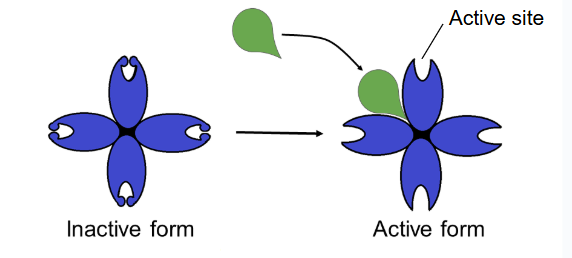
allosteric inhibitor
substrate binds to allosteric site and stabilizes the enzyme shape so that the active sites are closed/inactive
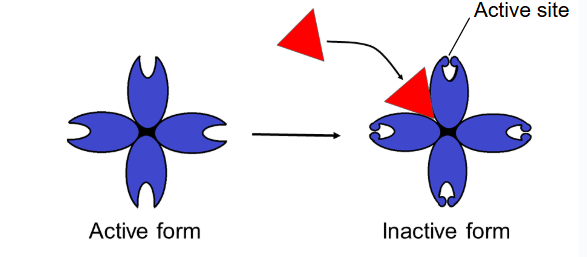
cooperativity
substrate binds with one active site (enzyme that has multiple) which stabilizes active form
considered allosteric regulation since binding at one site changes shape of others
Sometimes, the end product of a metabolic pathway can act as an inhibitor to an early enzyme in the same pathway
prevents excess products
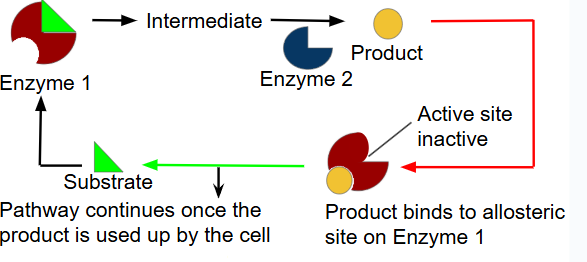
starch is the major fuel for animals
starch breaks down into glucose
cellular respiration is exergonic
oxidation of glucose transfers e- to a lower energy state, releasing energy to be used in ATP synthesis
downhill exergonic path:
glucose>nadh>etc>oxygen
Dehydrogenases
Oxidizing agent for glucose
take 2 e- and 2 protons from glucose
transfer 2e- and 1 proton to the coenzyme NAD+. Reduces to NADH (stores the energy, carries e- to the electron transport chain) last proton is release into surrounding solution
stages of cellular respiration
final e- acceptor aerobic
oxygen
makes h20 releases energy
nadh v nadph
nadh-cellular respiration
nadph-photosynthesis
photosynthesis
light energy to chemical
photosynthesis first developed in prokaryotic organisms
cyanobacteria: early prokaryotes capable of photosynthesis
Oxygenated the atmosphere of early Earth
foundation of eukaryotic photsynthesis
primary location of photosynthesis in most plants
leaves (mesophyll, the primary location of photosynthesis in most plants)
chloroplast
found in mesophyll’
surrounded by a double membrane
have stroma and thylakoid
stomata
pores in leaves that allow CO2 in and O2 out
stroma
aqueous internal fluid
Thylakoids
form stacks known as grana
Chlorophyll
green pigment in thylakoid membranes
simplified formula
6 CO2 + 6 H2O + light energy C6H12O6 + 6 O2
Redox reaction:
reaction involving complete or partial transfer of one or more electrons from one reactant to another
redox in photo synthesis
reduction co2 to glucose
water to oxygen
photo light reactions
in thylakoid
synthesis calvin cycle
in stroma
light
electromagnetic energy
Made up of particles of energy called photons
Travel in waves
Wavelength
the distance from the crest of one wave to the crest of the next
The entire range is known as the electromagnetic spectrum
380 nm to 750 nm is visible light
short wave high energy long wave low energy
cholorphyll a
Primary pigment
Involved in the light reactions
Blue/green pigment
Chlorophyll b:
Accessory pigment
Yellow/green pigment
cartotenoids
Broaden the spectrum of colors that drive photosynthesis
Yellow/orange pigment
Photoprotection- carotenoids absorb and dissipate excessive light energy that could damage chlorophyll or interact with oxygen
light reactions
light + H20 > O2 + ATP&NADPH
Occur in the thylakoid membrane in the photosystems
Converts solar energy to chemical energy(NADPH and ATP
The cell accomplishes this conversion by using light energy (photons) to excite electrons(
Chlorophyll absorbs a photon of light
e- is boosted from a ground state to an excited state
e- is unstable
Falls back to ground state
Releases energy as heat
Emits photons as fluorescence
Photosystems
reaction center and light capturing complexes
Photosystem 2: reaction center P680=Absorbs light at 680 nm
Photosystem 1: reaction center P700=Absorbs light at 700 nm
Reaction center:
a complex of proteins associated with chlorophyll a and an electron acceptor
Light capturing complexes
pigments associated with proteins
Think: antenna for the reaction centers
ps ii
PLight energy (photon) causes an e- to go from a ground state back to an excited state. This repeats until it reaches the P680 pair of chlorophyll a molecules (trapped energy travels till eventually reaches chlorophyll a)
The e- is transferred to a primary e- acceptor, forming P680+H2O is split into:
2 e- (Reduce P680+; go to ps I)
2 H+ (Released into thylakoid space)
1 oxygen atom (which immediately bonds to another oxygen atom)
Linear electron flow: each excited electron will pass from PS II to PS I via the electron transport chain (exits pq> cytochrome>pc)
The “fall” of electrons from PS II to PS I provides energy to form ATP
The H+ gradient is a form of potential energy
atp synthase
couples the diffusion of H+ to the formation of ATP
psi
Light energy excites electrons in the P700 chlorophyll molecules Become P700+
Electrons go down a second transport chain
NADP+ reductase catalyzes the transfer of e- from Fd to NADP+
reduces to NADPH
inputs and outputs of light reactions
in: H2O, ADP, NADP+
out: O2, ATP, NADPH
summary light reactions
converts solar to chemical (NADPH & ATP)
Water is split (hydrogen is source of electrons and protons H+, O2 released as by product)
light absorbed by chlorophyll drives transfer of electron and ions from water to NADP+ which is reduced to NADPH
ATP generated from ADP phosphorylated
calvin cycle
uses atp and nadph to reduce co2 to sugar (G3P)
for 1 G3P the cycle takes place 3 times
3 phases of calvin cycle
carbon fixation
reduction
regeneration of RuBP
carbon fixation
CO2 is incorporated one at a time
each attached to RuBP
this is catalyzed by rubisco (most abundant protein in chloroplasts)
forms 3-phocphoglycerate
reduction
each of 3-phosphoglycerate is phosphorylated by ATP(6 total)
becomes single bisphosphoglycerate which reduces to G3P
6 G3P are formed but only one is net cause other 5 r used to regen RuBP
regeneration of RuBP
5 G3P are used to regenerate 3 RuBP
uses 3 ATP
Cycle takes in CO2 again
inputs and outputs of calvin cycle
in: 3CO2, 9 ATP, 6 NADPH
out: 1 G3P, 9 ADP, 6 NADP+
calvin cycle summary
uses NADPH, ATP, and CO2
produces 2 C sugar G3P
three phases: carbon fixation
reduction
regeneration of RuBP